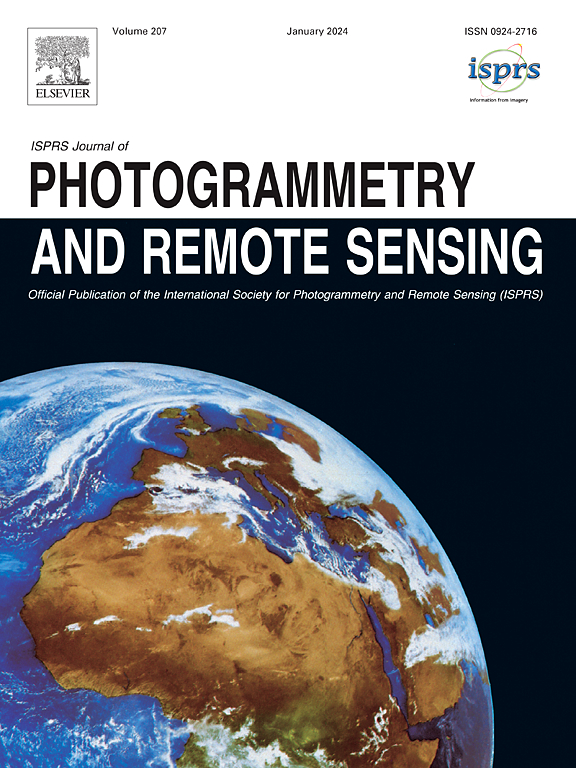Modeling hydrous mineral distribution on Mars with extremely sparse data: A multi-scale spatial association modeling framework
IF 10.6
1区 地球科学
Q1 GEOGRAPHY, PHYSICAL
ISPRS Journal of Photogrammetry and Remote Sensing
Pub Date : 2025-02-20
DOI:10.1016/j.isprsjprs.2025.02.003
引用次数: 0
Abstract
Identifying minerals on Mars is crucial for finding evidence of water on the planet. Currently, spectral inversion methods based on remote sensing data are primarily used; however, they only provide sparse and scattered maps of mineral exposures. To address this limitation, we propose a multi-scale spatial association modeling framework (MSAM) that couples the geographical distribution of Martian hydrous minerals with environmental factors based on the existence of spatial dependence, to achieve dense and continuous mapping of hydrous minerals. Our approach leverages explanatory variables – such as elevation, slope, and aspect – to establish spatial associations with potential areas of hydrous minerals, selected via multiscale search ranges from existing hydrous mineral exposures. These association results are used to identify potential hydrous mineral locations and estimate probabilities for potential hydrous mineral points. High-probability points are then combined with known exposures, and Kriging interpolation is applied to produce a continuous surface map. Finally, the interpolation results are evaluated using geomorphological maps, along with correlation analysis. The proposed MSAM enhances prediction accuracy and addresses the challenges of incomplete detection and undetected areas inherent in remote sensing-based spectral inversion. Results reveal that incorporating environmental factors reduces the RMSE by 25% and improves spatial correlation by 30% compared to traditional interpolation techniques. An overlay analysis intersecting the interpolated results with geomorphologic features obtained through semantic segmentation further demonstrates a coupling relationship between hydrous minerals and geomorphologic features within a specific spatial range.
基于极稀疏数据的火星含水矿物分布建模:一个多尺度空间关联建模框架
识别火星上的矿物质对于寻找火星上存在水的证据至关重要。目前主要采用基于遥感数据的光谱反演方法;然而,它们只能提供稀疏和分散的矿物暴露地图。为了解决这一问题,我们提出了一个多尺度空间关联建模框架(MSAM),该框架基于空间依赖性的存在,将火星含水矿物的地理分布与环境因素耦合起来,实现含水矿物的密集连续制图。我们的方法利用解释变量(如海拔、坡度和坡向)建立与潜在含水矿物区域的空间关联,这些区域是通过从现有含水矿物暴露的多尺度搜索范围中选择的。这些关联结果用于识别潜在含水矿物的位置和估计潜在含水矿物点的概率。然后将高概率点与已知曝光相结合,并应用克里格插值生成连续的表面图。最后,利用地貌图对插值结果进行评价,并进行相关分析。该方法提高了预测精度,解决了遥感光谱反演中探测不完全和未探测区域的问题。结果表明,与传统插值方法相比,将环境因素纳入插值后的均方根误差降低25%,空间相关性提高30%。将插值结果与语义分割得到的地貌特征进行叠加分析,进一步证明了特定空间范围内含水矿物与地貌特征之间的耦合关系。
本文章由计算机程序翻译,如有差异,请以英文原文为准。
求助全文
约1分钟内获得全文
求助全文
来源期刊

ISPRS Journal of Photogrammetry and Remote Sensing
工程技术-成像科学与照相技术
CiteScore
21.00
自引率
6.30%
发文量
273
审稿时长
40 days
期刊介绍:
The ISPRS Journal of Photogrammetry and Remote Sensing (P&RS) serves as the official journal of the International Society for Photogrammetry and Remote Sensing (ISPRS). It acts as a platform for scientists and professionals worldwide who are involved in various disciplines that utilize photogrammetry, remote sensing, spatial information systems, computer vision, and related fields. The journal aims to facilitate communication and dissemination of advancements in these disciplines, while also acting as a comprehensive source of reference and archive.
P&RS endeavors to publish high-quality, peer-reviewed research papers that are preferably original and have not been published before. These papers can cover scientific/research, technological development, or application/practical aspects. Additionally, the journal welcomes papers that are based on presentations from ISPRS meetings, as long as they are considered significant contributions to the aforementioned fields.
In particular, P&RS encourages the submission of papers that are of broad scientific interest, showcase innovative applications (especially in emerging fields), have an interdisciplinary focus, discuss topics that have received limited attention in P&RS or related journals, or explore new directions in scientific or professional realms. It is preferred that theoretical papers include practical applications, while papers focusing on systems and applications should include a theoretical background.
 求助内容:
求助内容: 应助结果提醒方式:
应助结果提醒方式:


